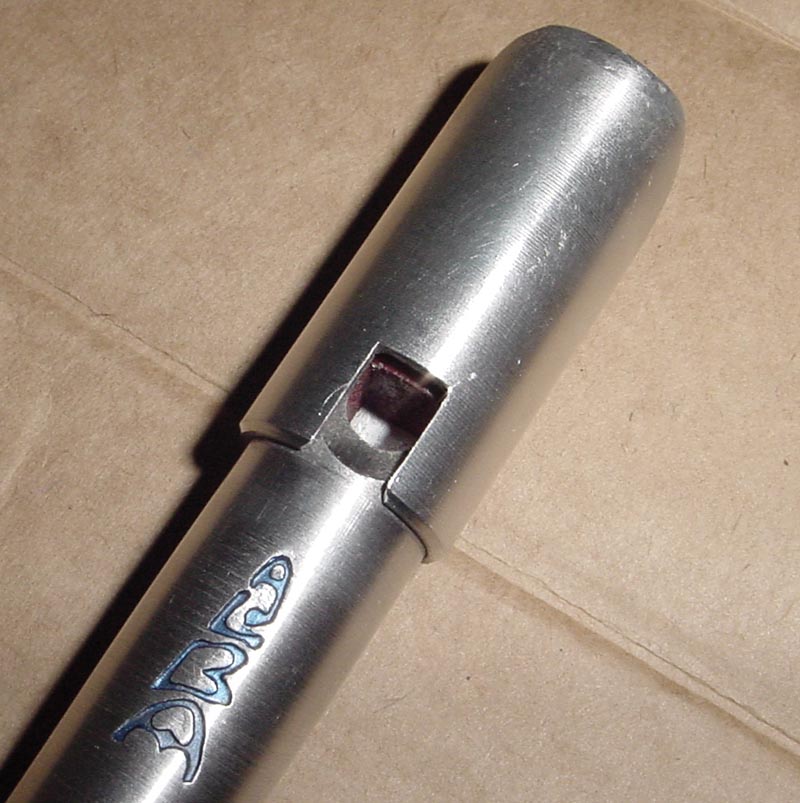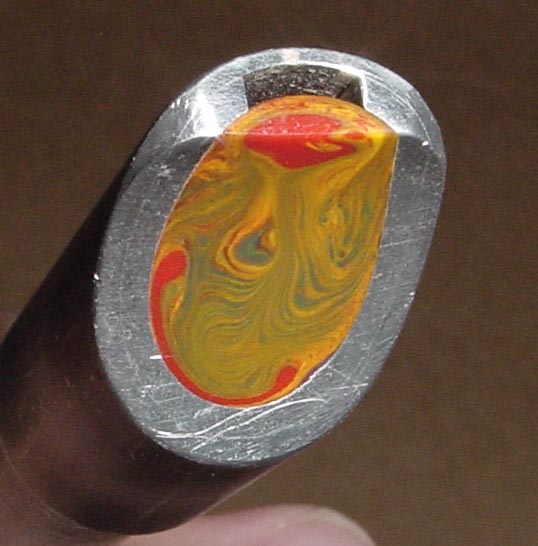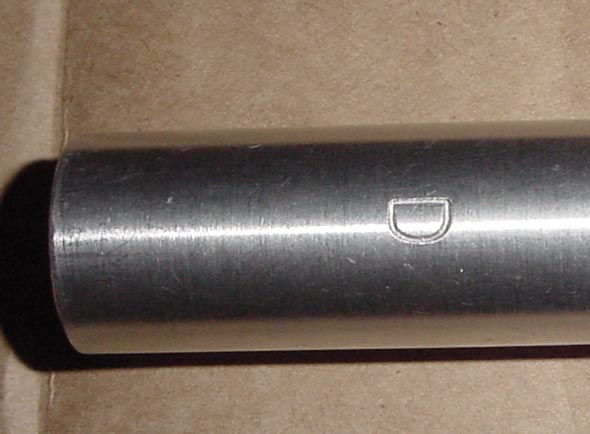Alba Soprano D Whistle Review
(Review written August 2005)
- Preface
- I've played a couple of Albas before: the Alba SE and an Alba low D. I had the low D most recently, nearly two years ago on a whistle tour, when I was in the process of settling in from my move to Dallas, so the review I gave it wasn't really up to my standards; there were no pictures, no tuning measurements, or anything like that. I took no notes and I actually wrote the review something like a couple of weeks after I sent the whistle on. So, I've been interested acquiring some other Alba whistles to review for the site.
- At a Glance
- Whistle Reviewed
- Alba Soprano D Whistle
- Models Available
- Alba Aerophonics makes tunable and non-tunable aluminum whistles, flutes, and flageolets in a variety of keys. They also make D and Bb whistles from tufnol.
- How Acquired
- Received on loan.
- Construction
- Aluminum with resin fipple plug.
- Price at Time of Review (in US Dollars unless otherwise noted)
- £55.00 (close to $100 USD)
- Available From
-
Stacey O'Gorman (Alba Aerophonics)
Big Whistle Music Shop
- Appearance
- The whistle is sleek aluminum, with a brushed-style finish. Some Alba whistles come with "fipple art", which was being developed around the time that I had the Alba SE for review. The art on the SE was nothing to write home about, but the technique really has come a long way and looks pretty nice now. I don't know if all Albas come with fipple art, so it's best to ask what's available before ordering.
-

Here's a close-up of the mouthpiece. Here you can see the half-moon labium ramp characteristic of many of the Alba whistles. A few whistles can be found which use this type of blade: The Serpent SweetPolly, the Kerry Songbird low D, the old McHaffie whistles, and of course quenas have had blades similar to this for ages. Just below the mouthpiece is the nicely stamped Alba logo.In this pic, you can get a good look at the finish of the whistle. I couldn't decide if the finish was "brushed" or was lines caused by machine lathing (this lathing look is more evident on the mouthpiece than the body). In any case, it does give a nice brushed appearance.
If you look down into the windway area here, you can see just a little bit of red from the fipple protruding into the voicing area and squaring it off. These fipple "tabs" or "wings" can be found in many modern whistle designs, such as Humphrey, Hoover, and Chieftain, and of course, Albas. These help to shape the wind geometry and stabilize the tone.

Here's another angle on the mouthpiece, showing the fipple area. The fipple is made of a resin that Stacey calls "Albanite". This swirly "fipple art" is the standard type (as well as a sparkly kind as well). Stacey also makes inlays of Celtic and Pictish art for her stand at the Celtic Connection in Glasgow, and sometimes for special order, though I didn't have an example of that to take a picture of.
I usually only shoot the last three holes of a whistle, to give an idea of how they're formed, but I wanted to get a shot of all 6 in this picture so that you can see that they're very slightly out of alignment. In all honesty, I didn't notice this at all as I was playing it, because it's slight, but was definitely noticeable the instant I did more than glance at the whistle. The holes aren't as neatly worked and polished as on the Overton whistle but I think it shows up far worse in pictures than it does in real life, so I didn't get a close-up.
Here's the foot of the whistle. I'm glad to see a discreet small stamped D like on a Chieftain, or an Overton, rather than the big hand-carved "D" that I didn't like on the Alba SE. Stacey tells me that she's been using this smaller D for the last 300 whistles or so that she's made, due to customer demand, and the fact that the bigger D introduced too much deformity into the barrel.
- Playing Characteristics
- Strong tone, with a loud and brash second octave. Has an underlying hiss that increases as you go up the range.
-
Sound clips of the whistle:
Lord Mayo
Off to CaliforniaVolume: As brash as the whistle is, it really feels a lot louder than it actually is. I originally was going to call this whistle "fairly loud" but comparisons showed it's really only about as loud as my Feadógs in the first octave. The second octave is louder than anything else I currently have in the house.
Responsiveness: Responsive. I didn't really have any trouble with this whistle, and in truth, lack of responsiveness is generally a characteristic to be concerned about with low whistles more than with soprano models.
Tuning: When warmed, this whistle can be blown into tune, if you don't mind jumping through a few hoops. The second octave D is around 30 cents sharp when blown with the expected breath, and you have to lower your breath almost to the point where it drops down to the first octave sound it in tune. The C# on this whistle has to be blown considerably harder than it's surrounding notes (B and 2nd octave D) to play in tune. If you blow at the same breath level as the surrounding notes, the C# is about 35 cents flat. F# requires a little extra push, too, but not as dramatic.
Like the old-style Chieftains, these whistles can be a bit of a challenge to keep warmed. In my house, it took a lot of care and attention, and if you put the whistle down for a minute, it was cold again. In my car in the morning (79 degree weather outside) it was much better. But this whistle sounded best playing outside in the afternoon in 98 degree weather. Inside, especially in air-conditioning, this whistle is going to be a challenge to keep warm. I definitely wasn't able to keep it warm enough to play at my local session.
C-natural: Like the C#, the C-natural requires quite a bit of push to be in tune when compared with the notes around it. Using OXXOOO if you blow at the same breath level as the surrounding notes, the C-natural 56 cents flat! OXOOOO is better, but even so you still need to push.
Hole size and placement: As I mentioned above, the holes are a little out of alignment, but nothing significant. Otherwise, the holes on this whistle are very similar to the Overton I reviewed recently, down to the little gap between the first three holes and the last three holes, and the D hole being a little away from the pack. I would expect most people to be comfortable with the hole placement.
Air volume requirements: Minimally above average. I run out of air on this whistle a few notes sooner on than with my Feadógs. In the second octave, the whistle a lot more air to keep it in tune. In my Off to California clip, the need to take a breath caught me by surprise near the end of the tune
Air pressure requirements: medium-High with constant emphasis. The entire whistle is not centered within the dynamic breathing range; what I mean by that is that there's a range of breath pressure in which you can sound a note. At it's lowest end, before the whistle cuts out, the note plays flat. At it's highest end, before you jump to the next octave, the note plays a sharp. This is true of most whistles, and most whistles have the "in-tune" spot more or less in the middle of this range. With the exception of the bell note, the Alba's "in-tune" spot is much closer to the octave break, meaning it's easy to go flat, but harder to go sharp. The whistle already takes more air than average, and on top of that I feel like I have to constantly push this whistle to keep it in tune, rather than playing at the more-comfortable mid-point of the breathing range. This is what I mean by "with emphasis". The Alba SE was similar, so I am assuming that it's a common playing characteristic of this maker's whistles. Some people like to play really exuberantly and "wail" on a whistle; this one would suit them just fine in that regard. Obviously, temperature affects this as well, and the whistle was a lot closer to being centered in the dynamic range outside in near-100 degree weather.
Clogging: This whistle tends to be a bit cloggy, like most aluminum whistles I've tried. If you can keep it warm, the tendency is less. I'm not sure if Duponol would help much, but since this whistle is on loan, I haven't tried it.
Wind Resistance: Great. I was able to play this whistle outside in a variety of locations without wind being much of a factor at all.
- Summary
- If you like sweet, soft, quiet, or easy playing instruments, definitely stay away from this one. If you're more inclined to really wail on a whistle like a rock star, then an Alba will hold up far better than it's more timid brethren. Like the Alba SE, this whistle is best played outdoors. It might make a decent Renaissance Festival whistle, but with it's tuning problems, I would probably be leery about playing it alongside other musicians in a band situation unless I had a lot of time with it and could be confident I could keep it under control. But the fact that it stays warm better outdoors, and handles the wind well, whereas indoors it tends to be cloggy and flat means I wouldn't be playing it in session much. Since most beginners don't like brash and loud instruments (like Susatos for instance) I imagine that they'd best be served with a tamer beast. I personally really like the first octave on the whistle, and wish the second were more like it.